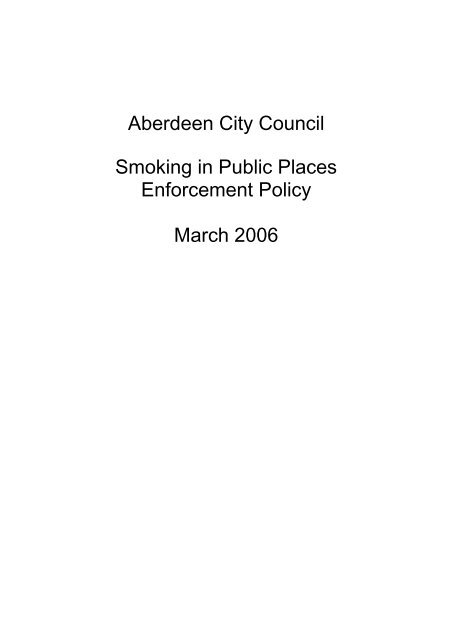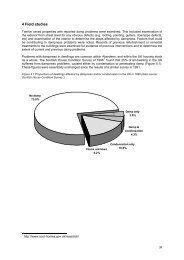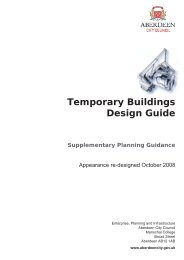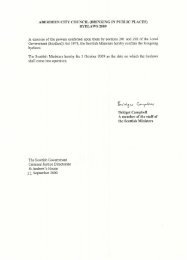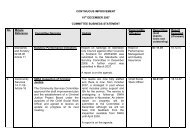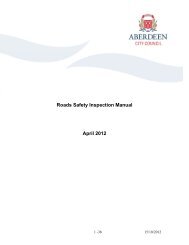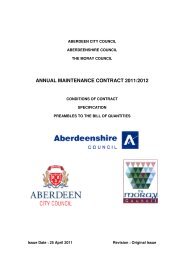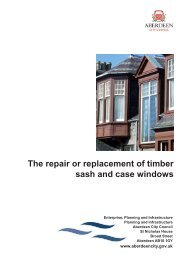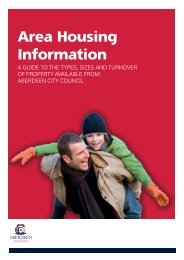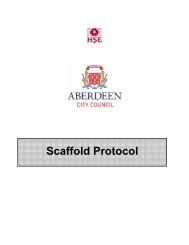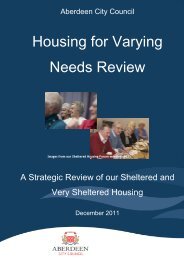Smoking Enforcement Policy - Aberdeen City Council
Smoking Enforcement Policy - Aberdeen City Council
Smoking Enforcement Policy - Aberdeen City Council
Create successful ePaper yourself
Turn your PDF publications into a flip-book with our unique Google optimized e-Paper software.
<strong>Aberdeen</strong> <strong>City</strong> <strong>Council</strong><strong>Smoking</strong> in Public Places<strong>Enforcement</strong> <strong>Policy</strong>March 2006
DefinitionsNo-smokingpremisesWholly orsubstantiallyenclosedSmoke“No-smoking premises” are those premises which are wholly orsubstantially enclosed and which are one of the premises orclasses of premises which are set out in the Prohibition of<strong>Smoking</strong> in Certain Premises (Scotland) Regulations 2005 (SeeAppendix 1)the legal definition of ‘wholly or substantially enclosed’ is set outin the aforementioned Regulations at regulation 3(b) and (c) andis available in Appendix 3. Put simply, it means premises orvehicles, which have a roof or top, and where applicable, wallson more than 50% of the perimeter of the premises that arepermanently or temporarily enclosed‘Smoke’– means smoke tobacco, any substance or mixturewhich includes it or any other substance or mixture; and aperson is to be taken as smoking if the person is holding orotherwise in possession or control of lit tobacco, of any litsubstance or mixture which includes tobacco or of any other litsubstance or mixture which is in a form or in a receptacle inwhich it can be smoked.3
The Act provides for two enforcement options:• Submission of reports to the Procurator Fiscal for prosecution; and• Fixed Penalty NoticesIt is the policy of this <strong>Council</strong> to utilise fixed penalty notices in the first instance whereappropriate.Offence Defence under Act Maximum fine iffound guiltySection 1 of ActPerson withmanagement or controlof no-smoking premisesknowingly permitsanother to smoke there.Section 1(3) of ActAccused can demonstrate that theytook all reasonable precautions andexercised all due diligence to avoidcommission of offence or there wasno lawful or practicable means bywhich the accused could preventLevel 4(£2,500)Section 2 of ActPerson smokes in nosmokingpremises.Section 3 of ActPerson havingmanagement or controlof no-smoking premisesfails to conspicuouslydisplay no-smokingsigns as required.Section 7(3) of ActPerson whoenforcement officerbelieves is committingor has committed any ofabove offences orbelieves to haveinformation relating tosuch an offence, andfails without reasonableexcuse to supply theofficer with their nameand address whenrequired to supply it.person from smoking there.Section 2(2) of ActAccused can demonstrate they did notknow and could not reasonably beexpected to have known premiseswere no-smoking.Section 3(1) of ActAccused can demonstrate that they(or any employee or agent of theirs)took all reasonable precautions andexercised all due diligence to avoidcommission of offence.Level 3(£1,000)Level 3(£1,000)Level 3(£1,000)5
Offence for which Fixed Penalty Notice is issuedSection 1 offence - person having management or control ofno-smoking premises fails to prevent others from smokingin those premises.Full DiscountedAmount amount£200 £150Section 2 offence - smoking in no-smoking premises. £50 £30Section 3 offence - person having management or control ofno-smoking premises fails to conspicuously display warningnotices in those premises.£200 £150The full amount of the fixed penalty as stipulated in the notice will be payable andmust be paid within 29 days beginning with the day on which the notice is given.However, a discounted amount is payable instead of the full amount if payment ismade before the end of the period of 15 days beginning with the day on which thenotice is given (if the last day does not fall on a working day, the period for paymentof the discounted amount is extended until the next working day).6
3 Statement of IntentThis <strong>Council</strong> will seek to ensure, through the provision of advice, education, publicity,guidance and, fair and reasonable formal enforcement action, that persons in controlof enclosed public places, their representatives, the public and other duty holderscomply with the smoking legislation.This enforcing authority will enforce the law through the principles of:proportionality 1 in applying the law and securing compliance;consistency 2 of approach;targeting 3 of enforcement action;transparency 4 about how we operate and what persons in control of enclosed publicplaces, their representatives, the public and other duty holders may expect from us;andaccountability 5 to all stakeholders for our actions.Our approach will also encompass the Vision, Mission and Values of <strong>Aberdeen</strong> <strong>City</strong><strong>Council</strong>, i.e. to demonstrate effective implementation of Best Value, maintain ourintegrity at all times, and be accountable for our actions.For the purposes of this <strong>Policy</strong>, an <strong>Enforcement</strong> Officer is any member of staffemployed by the <strong>Aberdeen</strong> <strong>City</strong> <strong>Council</strong> who is appointed by the <strong>Council</strong> under the<strong>Smoking</strong>, Health and Social Care (Scotland) Act 2005 and duly authorised in terms ofthe <strong>Council</strong>’s Delegated Powers.1 Proportionality means ensuring that the level of enforcement is proportionate to the risk, and the seriousness ofany breach of the law.2 Consistency relates to enforcement practice within this local authority, and also between this authority andother local authorities. Consistency does not mean uniformity, but means taking a similar approach in similarcircumstances to achieve similar ends.3 Targeting means ensuring enforcement activities, such as inspections and investigations, are focused onactivities giving rise to the greatest risk or the least well controlled.4 Transparency is the extent to which duty holders and the public are clear about what is expected of them andwhat they can expect from the enforcing authority in terms of advice and enforcement action.5 Accountabilty means that enforcing authorities must have policies and standards against which they can bejudged, and an effective and easily accessible mechanism for dealing with comments and handling complaints.7
4. <strong>Enforcement</strong> StrategyThe approach that this <strong>Council</strong> will take is to:a) Undertake a priority based pro-active inspection programme.b) Investigate all complaints in accordance with the procedure detailed in item 4.2c) Provide guidance and advice to persons in control of enclosed public places,their representatives, the public and other duty holders.d) Seek to educate persons in control of enclosed public places, theirrepresentatives, the public and other duty holders as to the requirementsregarding enclosed public places.e) Strive to achieve consistency in enforcement standards through staff training,quality procedures and active participation in all liaison arrangements with otherlocal authoritiesf) Provide guidance and advice to new businesses and new employers during theplanning stage of their venture.4.1 Inspections<strong>Enforcement</strong> activities will involve different approaches depending on thecircumstances.a. Announced inspection – <strong>Enforcement</strong> Officers will announce themselves to theperson in charge on entering the premises, and show appropriate identification,prior to assessing compliance with the law.b. Inspection/visit to the premises by <strong>Enforcement</strong> Officers prior to revealing theiridentity. Officers will assess compliance by observation within the premises, andsubsequently announce themselves and show appropriate identification to theperson in charge of the premises at the end of the period of inspection.c. Covert surveillance – specific investigation undertaken by <strong>Enforcement</strong> Officersto gather evidence of non compliance with the law, of the business or person incharge of the premises, where it is considered necessary and proportionate inthe circumstances and duly authorised by an appropriate officer of the <strong>Council</strong>.Visits may arise from a planned inspection programme, complaints or otherintelligence.Any directed covert surveillance will be undertaken in accordance with the Regulationof Investigatory Powers (Scotland) Act 2000, with the required authorisation beingobtained prior to any such covert surveillance being undertaken. Covert surveillancewill only be undertaken in circumstances where <strong>Enforcement</strong> Officers of the councilhave good reason to suspect that an offence under the Act is being committed, andthat evidence of the offence cannot be obtained in any other way8
4.2 Complaint InvestigationThe identity of the complainant will not be revealed during the investigation of anycomplaint.The response to complaints received about non-compliance with the legislation willbe prioritised taking into account the following factors:• The number of complaints received about a particular premises• The number of people likely to be affected if the complaint is about smoking in nosmoking premises• Whether the nature of the complaint suggests to the enforcing officer a degree ofcomplicity between the various parties in the alleged offence• Whether the alleged offender has been previously warned regarding noncomplianceAll complaints will be acknowledged within two working days, provided thecomplainant has given contact details.The overriding principles in the enforcement strategy in dealing with complaints willbe that of proportionality, consistency and transparency. If the investigation of acomplaint reveals non-compliance with the law, the Officer will select the mostappropriate enforcement response, taking into the factors described in section 5 ofthis <strong>Policy</strong> (Formal <strong>Enforcement</strong> Action). The complainant will be advised of theoutcome of the investigation, provided they have given this Service a contacttelephone number, e-mail address or home address.If the Officer feels that no action is required, or the complaint is not justified, then thecomplainant will be advised accordingly. If preliminary investigations reveal that thecomplaint is not within the scope or remit of this Enforcing Authority, then thecomplaint will be referred to the appropriate enforcement agency and thecomplainant advised of this action.4.3 Data Protection<strong>Enforcement</strong> Officers will ensure that they are aware of the <strong>Council</strong>’s Corporate<strong>Policy</strong> on Data Protection and only disclose information to authorised personnel, suchas, the Head of Service of Economic Environmental Sustainability, officers taskedwith undertaking the processing of fixed penalty notices and where appropriate, theProcurator Fiscal. Any disclosure to <strong>Council</strong> staff or the Procurator Fiscal will be inaccordance with the principles of the Data Protection Act 1998.9
5. Formal <strong>Enforcement</strong> ActionIn deciding upon the appropriate action, <strong>Enforcement</strong> Officers will have due regard tothis policy. The approach taken by the <strong>Council</strong>’s <strong>Enforcement</strong> Officers will follow theflow diagram detailed below.Initial Complaint orProgrammed VisitSubsequentComplaintYesNo Further Action No Report to PFYesNo Further ActionFirst VisitComply?Advisory LetterSubsequent VisitsComply?NoBlatant Disregard for Legislationor Deliberate Non-complianceBlatant Disregard for Legislationor Deliberate Non-complianceReport to PFYesFirst Offence?Warning LetterYesReport NextOffence to PFNoFixed PenaltyNotice2 Fixed PenaltyNotices?NoNo Further ActionInform LicensingBoard whereappropriate5.1 Advisory and Warning lettersAn <strong>Enforcement</strong> Officer will issue an advisory letter where no offences of thelegislation are identified. An advisory letter may contain recommendations on goodpractice. This may consist of a hand written sheet or word processed document.A warning letter will be issued on the first occasion that offences are identified, unlessthere is a blatant disregard for the legislation. It will provide details of the offencesidentified, the remedial work required and the time period for compliance. This mayconsist of a hand written record form or word processed document.10
5.2 Fixed Penalty NoticesA Fixed Penalty Notice will be issued when an offence has been identified and awarning letter has already been issued, or where there appears to have been blatantor systematic non compliance with the law.A Fixed Penalty Notice may be issued at the time if the authorising officer has reasonto believe that a person is committing an offence or has committed an offence or ifappropriate at a later date.A Fixed Penalty Notice will:• identify the offence to which it relates and give reasonable particulars of thecircumstances alleged to constitute that offence• state the amount of the penalty and the period within which it may be paid.• state the discounted amount and the period within which it may be paid.• state the person to whom and the address at which payment may be made (thismust be the local council for the area where the alleged offence was committed,or a person acting on behalf of the council).• state the method or methods by which payment may be made.• state the person to whom and the address at which any representations relatingto the notice may be made.• state the consequences of not making a payment within the period for payment.5.3 Reports to the Procurator FiscalThe <strong>Council</strong> will consider preparing a report to the Procurator Fiscal in one or more ofthe following situations:• there appears to have been blatant or systematic non compliance with the law;or• there have been repeated offences in an establishment, or in various branchesof a multiple concern; or• a fixed penalty notice has not been paid within the appropriate time period.In deciding whether to submit a report to the Procurator Fiscal for offences under the<strong>Smoking</strong>, Health and Social Care (Scotland) Act 2005, the following factors will alsobe taken into consideration:• whether there has been a blatant disregard for the law, particularly where theeconomic advantages of breaking the law are substantial and the law abidingare placed at a disadvantage to those who disregard it;• the general record and approach of the offender;11
• whether it is desirable to be seen to produce some public effect, including theneed to ensure remedial action and, through the punishment of offenders, todeter others from similar failures to comply with the law;• whether the evidence available provides a realistic prospect of conviction;• whether an enforcement officer has been obstructed in the lawful course oftheir duties• whether or not the offender has taken all necessary steps to prevent arecurrence of the problem;• the ability of any important witnesses and their willingness to co-operate6. Authorisation of OfficersAll <strong>Enforcement</strong> Officers will be appointed under the <strong>Smoking</strong>, Health and SocialCare (Scotland) Act 2005. When carrying out their duties, <strong>Enforcement</strong> Officers willalways be able to produce their authorisation on request.The following table outlines the degree of authority afforded to the various differenttypes of <strong>Enforcement</strong> Officer involved.AUTHORISATION OF OFFICERSArea of Work Scope of Permission Comments/ConditionsService ofadvisory andwarning lettersService of FixedPenalty Notices.Reports toProcurator Fiscal.All qualified EHOs andappropriately authorised<strong>Enforcement</strong> Officers.All qualified EHOs andappropriately authorised<strong>Enforcement</strong> Officers.All qualified EHOs andappropriately authorised<strong>Enforcement</strong> Officers mayprepare reports to theProcurator Fiscal. A decisionto submit a report to theProcurator Fiscal rests withthe Senior EHOCommercialTeam ManagerThe preparation of allreports to the Procuratorfiscal is monitored by theSenior EHO/CommercialTeam Manager, andsighted by the Head ofShelter and Environment(Central NeighbourhoodArea).12
7. Appeals and ComplaintsThe recipient of a fixed penalty notice has the right to request a hearing. Theprocedure will be clearly explained to the recipient in the notes contained within theNotice, but the request for the hearing must be made in writing and before thepayment period for the penalty (29 days) expires.In accordance with the <strong>Smoking</strong>, Health and Social Care (Scotland) Act 2005, theProcurator Fiscal will be notified on receipt of a request for a hearing.The <strong>Council</strong> will also hear and investigate any complaints or representations allegingunfair or inconsistent treatment by <strong>Enforcement</strong> Officers. These should be raised inthe first instance with the Senior Environmental Health Officer or Manager withresponsibility for the smoking ban. Any representations alleging unprofessionalconduct on the part of any of the <strong>Council</strong>’s <strong>Enforcement</strong> Officers should be submittedin writing to the Director of the Service. All such representations will be investigatedthrough the <strong>Council</strong>’s complaints procedure.13
Appendix 1“No-smoking premises” (as set out in Schedule 1 of the Prohibition of <strong>Smoking</strong>in Certain Premises (Scotland) Regulations 2006)• Restaurants.• Bars and public houses.• Shops and shopping centres.• Hotels.• Libraries, archives, museums and galleries.• Cinemas, concert halls, theatres, bingo halls, gaming and amusement arcades, casinos,dance halls, discotheques and other premises used for the entertainment of members ofthe public.• Premises used as a broadcasting studio or film studio or for the recording of aperformance with a view to its use in a programme service or in a film intended for publicexhibition.• Halls and any other premises used for the assembly of members of the public for socialor recreational purposes.• Conference centres, public halls and exhibition halls.• Public toilets.• Club premises.• Offices, factories and other premises that are non-domestic premises in which one ormore persons work.• Offshore installations.• Educational institution premises.• Premises providing care home services, sheltered housing or secure accommodationservices and premises that are non-domestic premises which provide offenderaccommodation services.• Hospitals, hospices, psychiatric hospitals, psychiatric units and health care premises.• Crèches, day nurseries, day centres and other premises used for the day care of childrenor adults.• Premises used for, or in connection with, public worship or religious instruction, or thesocial or recreational activities of a religious body.• Sports centres.• Airport passenger terminals and any other public transportation facilities.• Public transportation vehicles.• Vehicles which one or more persons use for work.• Public telephone kiosks.Note that all of the above are defined terms and so, in order to properly interpret the list,reference must be made to the interpretation provision in regulation 1(1) of the <strong>Smoking</strong>Regulations.14
Appendix 2Exemptions (as set out in Schedule 2 of the Prohibition of <strong>Smoking</strong> in CertainPremises (Scotland) Regulations 2006)Those premises or parts of premises which are exempt from the legislation are:• Residential accommodation• Designated rooms in adult care homes.• Adult hospices.• Designated rooms in psychiatric hospitals and psychiatric units.• Designated hotel bedrooms• Detention or interview rooms which are designated rooms.• Designated rooms in offshore installations.• Private vehicles.Note that all of the above are defined terms and so, in order to properly interpret the list,reference must be made to the interpretation provision in regulation 1(1) of the <strong>Smoking</strong>Regulations.15
Appendix 3Definitions of “wholly enclosed” and “substantially enclosed”(extract from the Prohibition of <strong>Smoking</strong> in Certain Premises (Scotland)Regulations 2006)"wholly enclosed" means–(i) for premises other than a vehicle or part of a vehicle, having a ceiling or roofand, except for doors, windows and passageways, wholly enclosed, whetherpermanently or temporarily; or(ii) for premises that are a vehicle, or part of a vehicle, having a top or roof and,except for doors, windows or exits, wholly enclosed, whether permanently ortemporarily;(c) "substantially enclosed" means–(i) for premises other than a vehicle or part of a vehicle, having a ceiling or roof and,except for doors, windows and passageways, substantially enclosed, whetherpermanently or temporarily; or(ii) for premises that are a vehicle, or part of a vehicle, having a top or roof and, exceptfor doors, windows or exits, substantially enclosed, whether permanently or temporarily,and in determining whether premises are "substantially enclosed", no account is to betaken of openings in which there are doors, windows or other fittings that can be openedor shut;(d) premises shall be taken to be "substantially enclosed" if–(i) the opening in the premises has an area; or(ii) if there is more than one, both or all those openings have an aggregate area,which is less than half of the area of the walls, including any other structures serving thepurpose of walls, which constitute the perimeter of the premises;(e) where an opening is in, or consists of the absence of, such walls or other structures or apart of them, their area shall be measured for the purposes of paragraph (d) as if it includedthe area of the opening16


